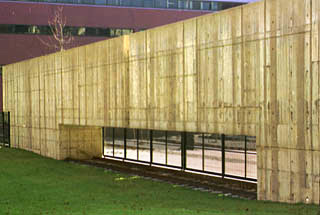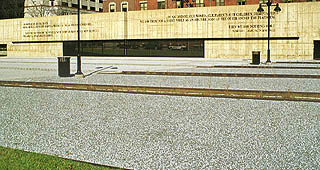
|
The Baltimore Holocaust Memorial is located at the intersection of Lombard and Gay Streets, two blocks from the Inner Harbor attractions. A concrete marker (shown at top) is located at the intersection, easily visible to motorists and pedestrians. In the front center sits the Joseph Sheppard Holocaust Sculpture. The statue depicts the horror of the Holocaust by portraying emaciated bodies of the victims’ bodies contorted in a ball of flame. The base of the sculpture bears the quote from George Santayana: Those who do not remember the past are destined to repeat it. The center plaza of the site is a large concrete triangle. The form represents the shape of the badge that the holocaust victims were required to wear. Two yellow triangles, one lying over the other, identified an individual as a Jew. The Holocaust Sculpture stands at the apex of the triangle. A raised triangular memorial plaque stands just behind the sculpture. The plaque contains an inscription prepared by Holocaust author Dr. Deborah Lipstadt: THE HOLOCAUST |
||
 More Info |
Deborah E. Lipstadt Dorot Professor of Modern Jewish and Holocaust Studies Emory University |
 |
|
On each side of the walkway triangle are 1940 vintage railroad tracks symbolizing the railway system that transported millions of Holocaust victims to the concentration camps. Ornamental grasses are planted between the tracks to represent an abandoned rail yard. Lamp posts representative of rail stations in the 1940s line the plaza. At the end of the plaza are two massive, cantilevered concrete blocks, each 80 feet long and 19 feet high that symbolize railway boxcars. There are steel wedges, at each end, that imply locomotive cowcatchers. The metal grates, in the center, represent the boxcar sides. Words of Holocaust survivor and author Primo Levi, from his autobiography Survival in Auschwitz, are inscribed on the sides of the concrete blocks. |
||
  
A black fence that
evokes the aura of a concentration camp |
||
The Baltimore Jewish Council is the
community relations and political arm of
THE ASSOCIATED: Jewish Community
Federation of Baltimore.
It represents Greater Baltimore area Jewish organizations
and
congregations on social, political and humanitarian issues that affect
Jews and the quality of life locally, nationally and worldwide.
Phone 410-542-4850
[Back]
